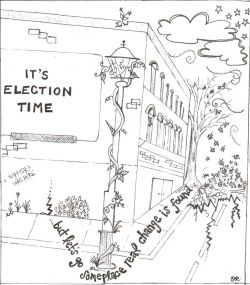Toronto Media Co-op
Local Independent News
Streetlight to Starlight: Into the night forest
Knowing the Land is Resistance is a project based in the remaining Carolinian forest around Lake Ontario. Our goal is to explore the ways that a deeper connection to wild spaces around us can advise our work as activists. For more, check out our website.
On a cool autumn evening, under huge streetlights that blot out the sky, we’re standing in the parking lot of University Plaza, at the edge of Dundas. Tonight, the urge to escape the city has become irresistible, and behind this plaza runs the hamilton-brantford rail trail. The trees that surround it are already in sight.
We are on the edge of what the city controls, approaching the area it does not. How far do the streetlights push into the trees, and how deep do you have to go before you can see the stars?
The city’s story tells us that these lights are here for our safety. And as we head west on the trail, at first the forest is thin and the city is tight on all sides, and we do feel vulnerable and afraid.
But with each step away from the city, we settle deeper into our senses and experience the night around us. Our eyes adjust to the darkness, and we enjoy the twisting moonlit branches above, and can make out familiar trees and plants beyond the edge of the trail. The cool forest air washes and refreshes our skin. The silence of the forest blossoms into a rich nocturnal chorus as our ears attune to their tiny noises: Night-crawlers crackle in the leaf-litter, pulling last year’s leaves underground to become soil.
With each step away from the city and into our senses, the forest becomes something we are a part of, rather than something to fear. We consider the many ways in which the city restricts our senses: streetlights, traffic noise, the stench of exhaust, the whine of electrical lines. This increases our disconnect from the world around us. By shedding our city-selves, we can come more deeply into our senses, and enter the forest without fear.
But what is this fear? Where does it come from? Within a forest, there exists sound we cannot hear but we feel. Sounds 20hrtz and below are inaudible to the human ear, yet we are able to experience these frequencies and we respond emotionally and physiologically. Massive mature hardwoods radiate these sounds. A forest grove is full of these low frequencies. They resonate within our bodies and stabilize our nervous systems, reducing stress and clearing our minds. We need the voices of the trees, the cool breath of the forest, and the presence of the stars to feel healthy and strong. The stress and irritability we feel in the city is perhaps a symptom of our alienation from the forest.
Continuing west, we pass a sign telling us that we’re now entering the Dundas Valley Conservation Area. This forest is claimed by the Hamilton Conservation Authority, and they installed this sign to tell us that we’re supposed to pay money for using this section of trail. And we recall what Gramma cautions: the law is on the side of the wealthy and greed is the cause of the earth’s destruction… We reject the expansion of the logic of capitalism over wild spaces – regardless of whether the intention is to develop or to conserve.
But suddenly, as we approach the rail trail visitor’s centre, flashing red and blue lights appear through the trees. What the fuck are cops doing in the forest? Flashlights are fumbling towards us, so we duck low and slip off the trail into the woods.
In the deep darkness now, we’re trying to be quiet, to hide, but we crack twigs with every step. A monsterous snort startles us as a buck bounds powerfully and easily through the tangle that we can barely navigate. We follow the hill down towards where he ran, trying to be so mindful of each movement, but we are the loudest things in the woods anyways. Looking back though, it was enough to escape the lights, for tonight.
We make our way to a grassy clearing. Lit up in clear moonlight, we reflect on where this escape from the city has taken us. Our clumsiness in the dark forest has shown us that although we can escape the city, it is not so easy to re-enter the forest. We feel some frustration at our ignorance and alienation. Our process is rooted in asking questions, in wondering about and exploring the land around us. Our questions lead to more questions, and new knowledge demonstrates how much we have left to learn.
The city offers us safety in return for our relationship with the land on which we depend. But the city’s safety is an illusion. We need to protect the health of the water and lands we depend on, and to do this, we must resist the current system. Actively working to oppose the destruction is the only true safety we have left, not more streetlights or more police.
A first step in this is to rebuild our relationships with wild spaces. Knowing the land is its own reward – a wider world of freedom and connection exists all around us, just outside of the city’s reach.
About the poster
The site for the Toronto local of The Media Co-op has been archived and will no longer be updated. Please visit the main Media Co-op website to learn more about the organization.
